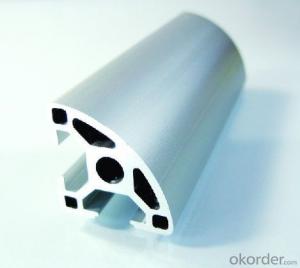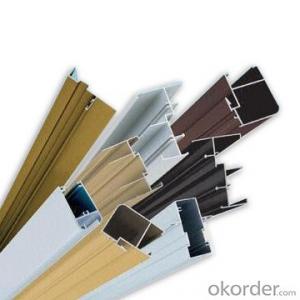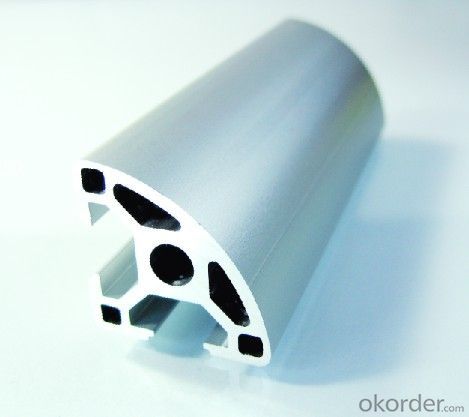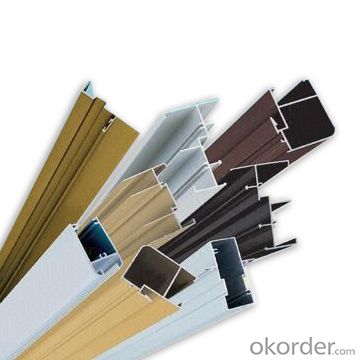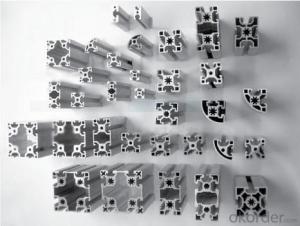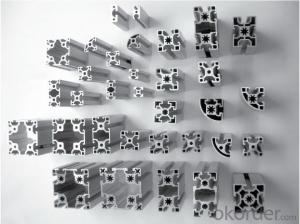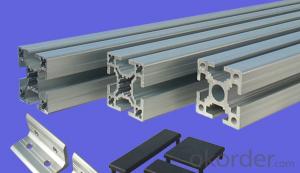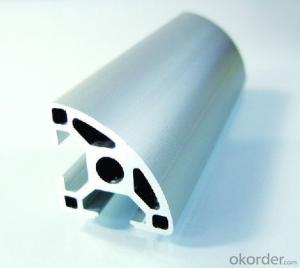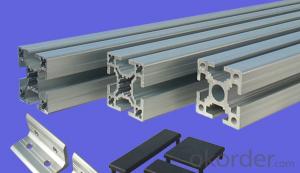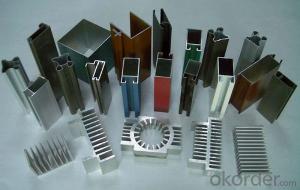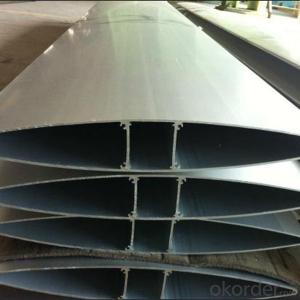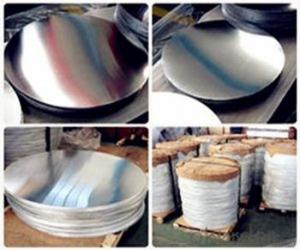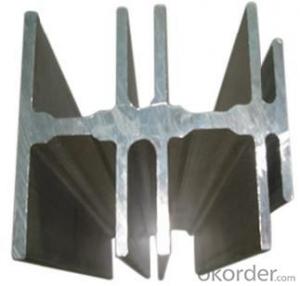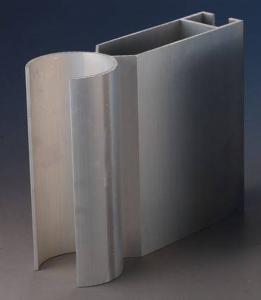Top Grade Kitchen Cupboard Aluminum Profiles India
OKorder Service Pledge
OKorder Financial Service
You Might Also Like
Aluminium is a relatively soft, durable, lightweight, ductileand malleablemetalwith appearance ranging from silvery to dull gray, depending on the surfaceroughness. It is nonmagnetic and does not easily ignite. A fresh film ofaluminium serves as a good reflector (approximately 92%) of visible lightand an excellent reflector (as much as 98%) of medium and far infraredradiation. The yield strength of pure aluminium is 7–11 MPa,while aluminium alloys have yield strengths ranging from200 MPa to 600 MPa. Aluminium has about one-third the densityand stiffness of steel. It is easily machined,cast, drawn and extruded.
Features:
Material | Alloy 6063,6061,6005or according to customer’s choice |
Temper | T3, T4, T5, T6 |
Surface | Anodize, electrophoresis, powder coating, PVDF coating, wood grain painting, matted, etc. |
Length | Coating 6.5 meters, Anodizing 6.5 meters, Mill finish 5 meters |
Application | Industrial, electrical equipment(TV set, air conditioner, refrigerator, computer), decoration,construction, transportation |
Custom Made | We can package following with customer's request. |
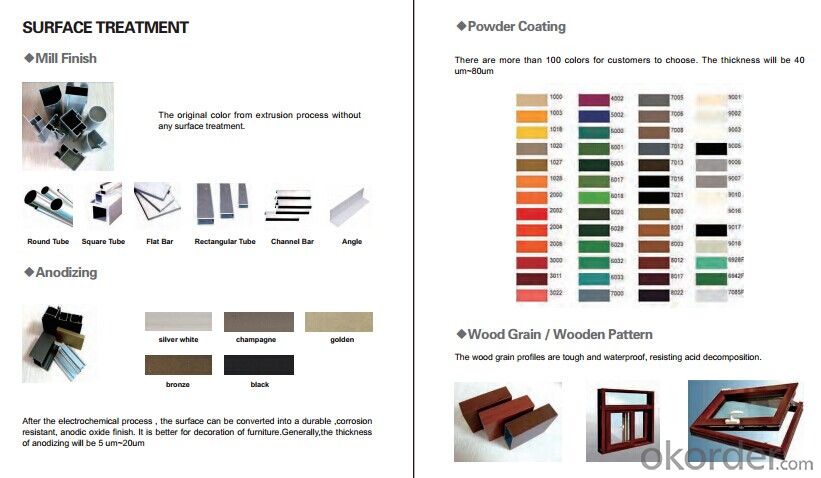
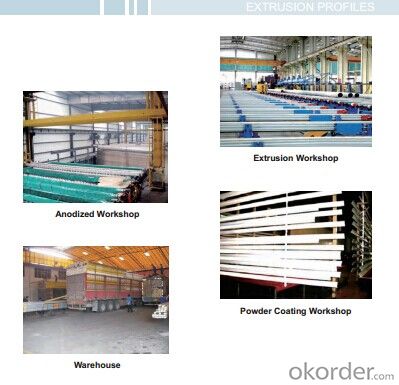

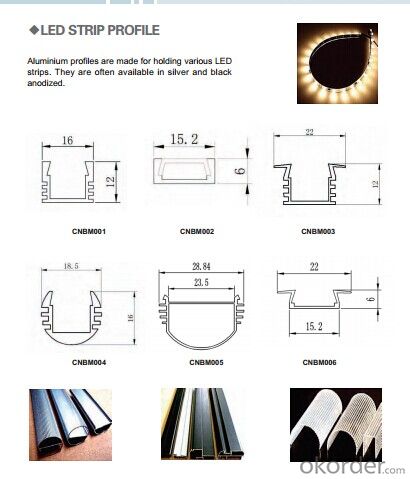
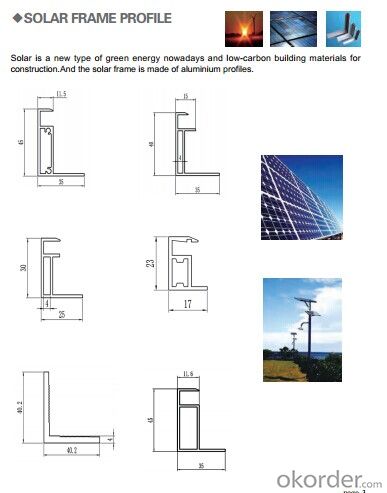

- Q: This question asks about the various types of aluminum profiles that are specifically used for flooring applications.
- <p>Aluminum profiles for flooring are designed to provide structural support and stability to the flooring system. Common types include: 1. T-profiles, which are used as support beams and can be easily connected to create a grid structure. 2. U-profiles, often used as edge trims or for creating a border around the flooring area. 3. H-profiles, which are suitable for heavy-duty applications and provide high load-bearing capabilities. 4. L-profiles, used for creating corners or edges in flooring systems. 5. C-profiles, which are used for covering or hiding the edges of the floor. Each type offers different benefits and is chosen based on the specific requirements of the flooring project, such as load capacity, aesthetic considerations, and ease of installation.</p>
- Q: Are aluminum profiles suitable for automotive heat exchangers?
- Automotive heat exchangers can effectively utilize aluminum profiles due to their numerous advantages. Firstly, aluminum possesses outstanding thermal conductivity, enabling efficient heat transfer between mediums. This quality allows aluminum heat exchangers to effectively dissipate heat generated by vehicle components such as the engine or transmission. Secondly, aluminum profiles are both lightweight and strong, making them a preferred option in the automotive industry. Weight reduction is crucial for improved fuel efficiency and performance, and aluminum heat exchangers contribute to this goal. By utilizing aluminum, overall weight is reduced, resulting in better handling, acceleration, and energy efficiency. Furthermore, aluminum exhibits high resistance to corrosion, even in harsh environments, making it highly suitable for automotive applications. This corrosion resistance ensures the durability and reliability of heat exchangers, reducing maintenance and replacement costs. Additionally, the manufacturing and formation of aluminum profiles into complex shapes is a simple task. This flexibility in design allows for customized heat exchanger designs that meet specific automotive requirements. The ability to efficiently utilize available space and maximize heat exchange surface area enhances overall performance. In conclusion, aluminum profiles are an excellent choice for automotive heat exchangers due to their exceptional thermal conductivity, lightweight yet strong properties, corrosion resistance, and design flexibility. These qualities make aluminum the ideal material for effectively managing heat in vehicles, resulting in improved performance, fuel efficiency, and durability.
- Q: How do aluminum profiles perform in seismic or earthquake-prone areas?
- Aluminum profiles have proven to be highly effective in seismic or earthquake-prone areas due to their unique properties. The lightweight nature of aluminum makes it a popular choice for construction in such areas as it reduces the overall weight of the structure, thus minimizing the potential for collapse during an earthquake. Additionally, aluminum possesses excellent ductility, meaning it can deform under stress without fracturing, which allows it to absorb and dissipate the energy generated by seismic activity. Moreover, aluminum profiles have high strength-to-weight ratio, allowing them to withstand the dynamic forces exerted during an earthquake. This strength, combined with the material's corrosion resistance, makes aluminum profiles particularly suitable for seismic areas where the risk of structural damage is heightened. Furthermore, aluminum is a highly malleable material, making it easy to shape and fabricate into various structural components. This flexibility allows for the creation of customized designs that can withstand seismic forces. Additionally, aluminum profiles can be easily bolted or welded together, providing a secure and reliable connection that further enhances the structural integrity of the building. It is important to note that the performance of aluminum profiles in seismic areas also depends on the overall design and construction techniques used. Proper engineering practices, such as incorporating seismic bracing systems or using specialized connectors, can further improve the performance of aluminum structures during earthquakes. Overall, due to its lightweight, ductile, strong, and corrosion-resistant properties, aluminum has proven to be a reliable and effective material for use in seismic or earthquake-prone areas. When appropriately designed and constructed, aluminum profiles can significantly enhance the safety and resilience of structures in these challenging environments.
- Q: Are aluminum profiles painted by powder or by fluorocarbon spray? How can they be distinguished from appearance?
- The biggest weakness of powder spraying is that it is afraid of the ultraviolet radiation of the sun. The long-term radiation will cause the natural fading. The face of the aluminum plate and the non bright face are obviously different in color after a few years, and the color difference is obvious for 2-5 years. Now appearing on the market name of color for aluminum, aluminum doors and windows, is to use ordinary aluminum powder coating and. Aluminum doors and windows to increase color varieties, but also to enhance corrosion resistance. Another kind of electrostatic spraying liquid spraying, also called fluorocarbon spraying called curium oil, Hongkong. Belonging to high-grade spraying, higher prices, has long been applied in foreign countries. In the past two years, it has been widely used in aluminum curtain wall. Because of its excellent characteristics, more and more attention has been paid to the construction industry and users. Fluorocarbon coating has excellent anti fade, anti frost, anti air pollution (acid rain) corrosion, anti UV ability, strong crack resistance and can withstand harsh weather conditions. Is less than general paint
- Q: Are aluminum profiles suitable for use in automotive suspension systems?
- Yes, aluminum profiles are suitable for use in automotive suspension systems. Aluminum is a lightweight and strong material that offers several advantages in suspension design. Firstly, the lightweight nature of aluminum profiles helps to reduce the overall weight of the suspension system. This not only improves fuel efficiency but also enhances the performance and handling of the vehicle. The reduced weight allows for quicker acceleration, better braking, and improved maneuverability. Secondly, aluminum profiles have excellent strength-to-weight ratio, meaning they can withstand high loads and stresses while still being lightweight. This makes them ideal for handling the dynamic loads experienced by suspension systems, such as bumps, vibrations, and impacts. Aluminum profiles can effectively absorb and distribute these loads, providing a smooth and comfortable ride for the occupants of the vehicle. Additionally, aluminum is resistant to corrosion, which is a critical factor in automotive applications. The suspension system is exposed to various environmental conditions, including moisture, salt, and road debris. By using aluminum profiles, the risk of corrosion is minimized, leading to increased durability and longevity of the suspension components. Furthermore, aluminum profiles are highly versatile and can be easily shaped and formed into complex geometries required for suspension system components. This allows for greater design flexibility and optimization of performance. Aluminum profiles can be used to manufacture various suspension components, including control arms, knuckles, and subframes. In conclusion, aluminum profiles are indeed suitable for use in automotive suspension systems. Their lightweight, high strength-to-weight ratio, corrosion resistance, and design flexibility make them an excellent choice for optimizing the performance, efficiency, and durability of suspension systems in vehicles.
- Q: Are aluminum profiles suitable for medical equipment?
- Yes, aluminum profiles are suitable for medical equipment. Aluminum is a lightweight, yet strong material that offers excellent corrosion resistance, making it ideal for use in medical equipment. It can be easily fabricated into various profiles and shapes to meet specific requirements. Additionally, aluminum is non-toxic, non-magnetic, and easily sterilizable, making it safe for use in medical environments. Its durability and resistance to wear and tear also contribute to its suitability for medical equipment, ensuring long-lasting and reliable performance.
- Q: In aluminum processing, countersunk holes and via holes what difference?
- Through holes in the positioning hole, the screw hole, and the screw cap is countersunk hole sink don't come out.AskI can't understand you..Chasing the answerThe countersunk head is where the screw cap sinks and the through-hole is threaded to avoid the hole
- Q: How do aluminum profiles perform in terms of impact resistance?
- Aluminum profiles are known for their excellent impact resistance. Due to their inherent strength and durability, aluminum profiles can withstand significant impact without getting deformed or damaged easily. The high strength-to-weight ratio of aluminum makes it ideal for applications where impact resistance is crucial, such as in the automotive, aerospace, and construction industries. Aluminum profiles have the ability to absorb and distribute impact energy throughout their structure, which helps prevent localized damage. This property is particularly beneficial in situations where the material needs to withstand sudden shocks, collisions, or heavy loads. Furthermore, aluminum profiles can also be designed with specific reinforcements or structural elements to enhance their impact resistance further. This allows for customization to meet specific requirements or to address potential impact-prone areas. Overall, aluminum profiles are highly regarded for their exceptional impact resistance, making them a preferred choice in various industries and applications where durability and strength are vital.
- Q: Are aluminum profiles suitable for use in the renewable energy industry?
- Aluminum profiles are well-suited for the renewable energy sector, offering numerous benefits. To begin with, aluminum is a versatile and lightweight material, making it ideal for renewable energy applications. The corrosion resistance of aluminum profiles is exceptional, allowing them to withstand outdoor conditions and moisture exposure. This durability ensures the longevity and structural integrity of the profiles. Moreover, the recyclability of aluminum profiles makes them an environmentally friendly choice for the renewable energy industry. With the industry's focus on reducing carbon footprint and promoting sustainability, aluminum's recyclability plays a crucial role in achieving these objectives. Aluminum can be recycled repeatedly without losing its essential properties, reducing the necessity for extracting and processing new raw materials. Another advantage of aluminum profiles is their design flexibility, enabling the creation of intricate shapes and structures tailored to specific requirements. This versatility makes them suitable for various renewable energy applications, including solar panel frames, wind turbine components, and mounting systems. Additionally, the lightweight nature of aluminum profiles simplifies transportation and installation processes, resulting in cost and energy savings. In conclusion, the corrosion resistance, recyclability, design flexibility, and lightweight properties make aluminum profiles an excellent choice for the renewable energy industry. These characteristics contribute to the efficiency, durability, and sustainability of renewable energy systems, establishing aluminum profiles as a fitting material for this sector.
- Q: Can aluminum profiles be subjected to painting or coating processes to enhance their aesthetic appeal and longevity?
- <p>Yes, aluminum profiles can be painted or coated to improve their appearance and durability. The process usually involves cleaning the aluminum to remove any contaminants, followed by a conversion coating to enhance adhesion. After that, a primer is applied, and finally, the paint or coating is applied. This not only enhances the visual appeal but also protects the aluminum from corrosion and wear, extending its lifespan.</p>
Send your message to us
Top Grade Kitchen Cupboard Aluminum Profiles India
OKorder Service Pledge
OKorder Financial Service
Similar products
Hot products
Hot Searches
Related keywords
